- Sorry, this product is unavailable.
-
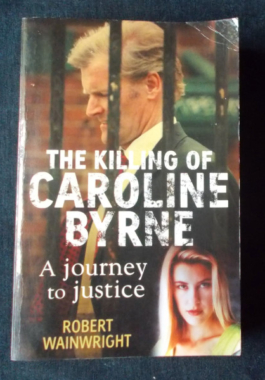 On a bleak, moonless winter night in 1995 beautiful Sydney model Caroline Byrne died, her body embedded head-first into a crevice at the bottom of The Gap at the entrance to Sydney Harbor. How did she get out so far, almost 12 meters from the base of the sheer sandstone precipice? Did she jump, as so many had done before at the notorious suicide spot, or had she been thrown in a fit of rage? What began as a sad ritual of retrieving the shattered bodies of shattered lives turned into one of the nation's most extraordinary murder investigations, leading to the dark heart of a city gripped by greed, pandering to its powerful and exposing a police force whose lack of imagination and resources was surpassed only by the doggedness of its finest officers to right an unforgivable wrong. this is a journey to justice: the astonishing inside story of Caroline's father Tony Byrne's determination to find the truth of his daughter's death and in doing so, test the justice system to its limits.
On a bleak, moonless winter night in 1995 beautiful Sydney model Caroline Byrne died, her body embedded head-first into a crevice at the bottom of The Gap at the entrance to Sydney Harbor. How did she get out so far, almost 12 meters from the base of the sheer sandstone precipice? Did she jump, as so many had done before at the notorious suicide spot, or had she been thrown in a fit of rage? What began as a sad ritual of retrieving the shattered bodies of shattered lives turned into one of the nation's most extraordinary murder investigations, leading to the dark heart of a city gripped by greed, pandering to its powerful and exposing a police force whose lack of imagination and resources was surpassed only by the doggedness of its finest officers to right an unforgivable wrong. this is a journey to justice: the astonishing inside story of Caroline's father Tony Byrne's determination to find the truth of his daughter's death and in doing so, test the justice system to its limits. -
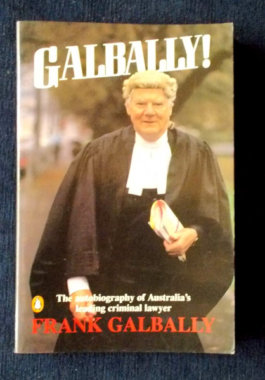
Galbally! Frank Galbally
$9.00Frank Galbally CBE (1922 - 2005) dominated Australian Law for over four decades, frequently at the centre of controversy and always at the heart of things. He represented everyone from painters and dockers to a talking cockatoo; had audiences with popes and took on the Greek Colonels and was embroiled in the politics of 1975 and the policies of Collingwood Football Club. The Krope trial, the Costigan Commission, Kevin Barlow's appeal...the number of legal trials in which Galbally was involved extraordinary and the names became household words. This autobiography contains some of his most famous cases, with a few fighting words regarding crucial aspects of Australian public affairs such as police corruption and the royal commission into crime. Illustrated with black and white photographs. -
 The case of Dr. Crippen has passed into folklore as one of the most infamous in criminal history. The year: 1910. The details: a hideously mutilated body in the cola cellar, a dockside arrest in Canada - by the means of the new wireless telegraph - of Crippen and his mistress, disguised as a boy, the trial with legal luminaries and society notables. There was enough sensation to place Crippen in the top ranks of master criminals. Yet Crippen was a quiet, meek little man, a hen-pecked husband who was always gentle with his shrewish wife, a business failure passionately in love with his competent young secretary, a bungler whose one venture into murder went wrong at every step of the way. This study examines the character of the man many believed incapable of murder and reveals the story of a mismatched marriage and a love affair that - out of its context - would have been an inspiration. Illustrated with black and white photographs. Appendix reproduces Crippen's letters to Ethel LeNeve, written from Pentonville Prison.
The case of Dr. Crippen has passed into folklore as one of the most infamous in criminal history. The year: 1910. The details: a hideously mutilated body in the cola cellar, a dockside arrest in Canada - by the means of the new wireless telegraph - of Crippen and his mistress, disguised as a boy, the trial with legal luminaries and society notables. There was enough sensation to place Crippen in the top ranks of master criminals. Yet Crippen was a quiet, meek little man, a hen-pecked husband who was always gentle with his shrewish wife, a business failure passionately in love with his competent young secretary, a bungler whose one venture into murder went wrong at every step of the way. This study examines the character of the man many believed incapable of murder and reveals the story of a mismatched marriage and a love affair that - out of its context - would have been an inspiration. Illustrated with black and white photographs. Appendix reproduces Crippen's letters to Ethel LeNeve, written from Pentonville Prison. -
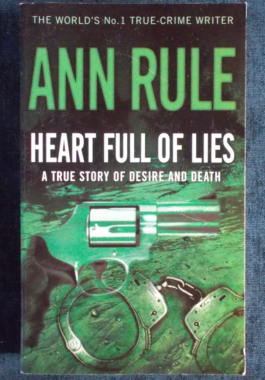
Heart Full Of Lies: Ann Rule
$10.00Liysa and Chris Norton seemed the perfect couple: Chris - tall, athletic and handsome, a pilot for Hawaiian Airlines; Liysa - attractive, seductive, an acclaimed surf photographer. Their son, Bjorn, looked just like his dad and they were raising Liysa's son by a previous marriage. They had beautiful homes on the mainland and in Hawaii. But soon after their idyllic marriage on a moonlit beach, Liysa revealed a rapacious side that Chris had not seen before, and she complained to her friends that Chris was a heavy drinker who beat her. Chris struggled to keep the marriage from unravelling but on a sunny morning in October 2000 he lay dead at a remote campsite. Liysa drove in distress to a friend's house - it appeared that she had been attacked and claimed that she had shot Chris in self-defence but the Oregon state detectives were suspicious of her account. Crime scene evidence led detectives to wonder if Liysa was a killer, not a victim. Her controversial trial stunned all who thought they knew her. A lifetime of sociopathic manipulations and lies had been expertly hidden behind her façade of perfection - as was her rage to destroy any obstacle to her ultimate happiness, even if it was the man she vowed to love forever. -
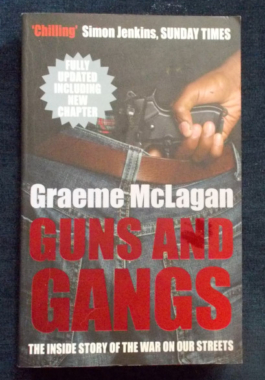 McLagan lifts the lid on a hugely important modern-day problem; an expensive both in terms of money and young lives. After terrorism, the single greatest worry for law enforcement agencies is gun crime and in particular 'black on black' shootings. McLagan has had exclusive access to police files and case histories. Together with his findings from these records are interviews with police officers, victims and their families, witnesses, lawyers and perpetrators of gun crime. The result is a unique and horrifying exposé of the disturbing truth behind this plague on the streets.
McLagan lifts the lid on a hugely important modern-day problem; an expensive both in terms of money and young lives. After terrorism, the single greatest worry for law enforcement agencies is gun crime and in particular 'black on black' shootings. McLagan has had exclusive access to police files and case histories. Together with his findings from these records are interviews with police officers, victims and their families, witnesses, lawyers and perpetrators of gun crime. The result is a unique and horrifying exposé of the disturbing truth behind this plague on the streets. -
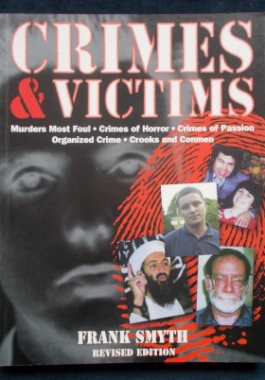
Revised Edition. Here are the true life stories of men and women who have shocked the world with their outrageous crimes - and those who have suffered and paid the price. Featured in this gallery of ultimate criminals: Dr, Crippen; Jeremy Bamber; The Boston Strangler; George Haigh; Snyder and Grey; Harold Shipman; Ted Bundy; Donald Neilson; Peter Sutcliffe; Ian Huntley; Dennis Nilsen; Fred and Rosemary West; Brady and Hindley; Ruth ellis; Sam Sheppard; The Krays; Al Capone; The Great Train Robbery; Osama Bin Laden; Timothy McVeigh; Ilich Ramirez Sanchez. Illustrated with haunting black and white photographs.
-
 After fourteen years of marriage, Mel Jacob's life looked as perfect as the roses perched above her white picket fence. The nice house in the suburbs, two great kids, a good husband. Until...her seemingly saintly husband was jailed for two years. This recounts Mel's funny, moving and insightful journey as she navigates single parenthood, prison visitations and nosy neighbours...and tells of the family left behind: the grief, the stigma and the conversational minefields of her husband's whereabouts, as well as the logistical problems of making a baby sibling for her two children, and why it's not appropriate to tell people that Daddy's in jail. 'So why did you marry Dad?' my daughter asked. 'Well, over time I got to know him and he made me laugh, and - and I knew deep down that, that even though we were really different...he was a good person.' Without skipping a beat, she said, 'He's not that good, he's in jail!'.
After fourteen years of marriage, Mel Jacob's life looked as perfect as the roses perched above her white picket fence. The nice house in the suburbs, two great kids, a good husband. Until...her seemingly saintly husband was jailed for two years. This recounts Mel's funny, moving and insightful journey as she navigates single parenthood, prison visitations and nosy neighbours...and tells of the family left behind: the grief, the stigma and the conversational minefields of her husband's whereabouts, as well as the logistical problems of making a baby sibling for her two children, and why it's not appropriate to tell people that Daddy's in jail. 'So why did you marry Dad?' my daughter asked. 'Well, over time I got to know him and he made me laugh, and - and I knew deep down that, that even though we were really different...he was a good person.' Without skipping a beat, she said, 'He's not that good, he's in jail!'. -
 The criminals who ended their days in Strangeways Prison - and the crimes that sent them there. A collection of murder cases from around Manchester each of which ends in the accused being executed at Strangeways Prison. Some of the accounts, at the end, feature an author's note in which suggests that perhaps the accused was innocent and should not have been hanged...Many a lot of these crimes are particularly shocking, evil and unmotivated. There is also a first-hand account written by Charles Parton, who was sentenced to death for murder and served 11 years before being found not guilty.
The criminals who ended their days in Strangeways Prison - and the crimes that sent them there. A collection of murder cases from around Manchester each of which ends in the accused being executed at Strangeways Prison. Some of the accounts, at the end, feature an author's note in which suggests that perhaps the accused was innocent and should not have been hanged...Many a lot of these crimes are particularly shocking, evil and unmotivated. There is also a first-hand account written by Charles Parton, who was sentenced to death for murder and served 11 years before being found not guilty. -
 Ronald Joseph Ryan was hanged in Melbourne on February 3, 1967, following his conviction for the shooting murder of a prison warder during a daring escape from the maximum-security Pentridge prison thirteen months before. The decision of the Victorian government in December 1966 to proceed with Ryan’s death sentence sparked immediate media condemnation and angry political protests, and put the Liberal premier, Sir Henry Bolte, under siege for the duration of the case. State governments around the country moved to abolish the death penalty in the 1970s and 1980s, and Ronald Ryan became the last man to be hanged in Australia. But who was Ronald Ryan, and how did he come to be the focus of such dramatic political events? Drawing on previously unpublished documents and personal accounts — including details of Ryan’s childhood and his early turn to crime — this book reveals the truth about Ryan’s guilt. It also goes behind the scenes to tell for the first time of the life-long anguish of the judge who pronounced the death sentence, the inner workings of the secret cabinet meeting that decided Ryan’s fate, and the dramatic political process that resulted in the rejection of eleventh-hour appeals to save Ryan. Illustrated with black and white photographs.
Ronald Joseph Ryan was hanged in Melbourne on February 3, 1967, following his conviction for the shooting murder of a prison warder during a daring escape from the maximum-security Pentridge prison thirteen months before. The decision of the Victorian government in December 1966 to proceed with Ryan’s death sentence sparked immediate media condemnation and angry political protests, and put the Liberal premier, Sir Henry Bolte, under siege for the duration of the case. State governments around the country moved to abolish the death penalty in the 1970s and 1980s, and Ronald Ryan became the last man to be hanged in Australia. But who was Ronald Ryan, and how did he come to be the focus of such dramatic political events? Drawing on previously unpublished documents and personal accounts — including details of Ryan’s childhood and his early turn to crime — this book reveals the truth about Ryan’s guilt. It also goes behind the scenes to tell for the first time of the life-long anguish of the judge who pronounced the death sentence, the inner workings of the secret cabinet meeting that decided Ryan’s fate, and the dramatic political process that resulted in the rejection of eleventh-hour appeals to save Ryan. Illustrated with black and white photographs.


